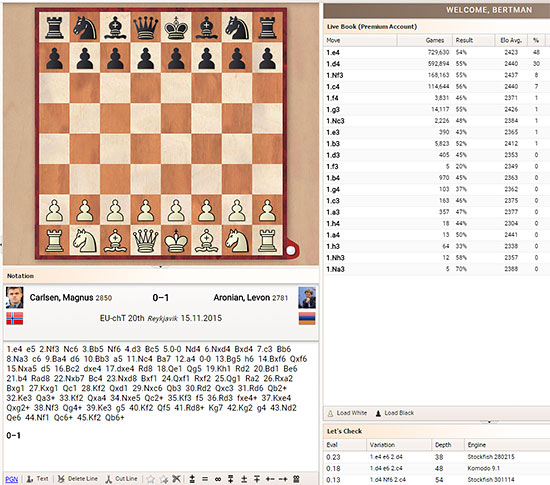


With the introduction of the ChessBase Account service, granting a wide range of new options to Premium subscribers, not only were new web apps made available, but existing ones were completely revised and revamped. Among them is the Live Database, which evolved from mere searches to a powerful feature-rich tool.

Accessing the Live Database could not be easier. On the right of this article, there is a long
menu for ChessBase Account features. Just click on Live Database.
Tip: if you press the Ctrl key on your keyboard while clicking on Live Database with the mouse, it will open it in a separate tab, and not close this page.

Upon opening, it will offer you the chance to login with your Chessbase (Playchess) account.
This will open up all its features for you.

A question that was probably not properly answered is on the compatibility with alternate operating systems. Since this is not a Windows program, but rather a special program (app) that runs within the browser, it means that so long as you are connected to the internet and running a modern browser such as Mozilla Firefox (for example), all these apps, including the Live Database, should run perfectly in all of these operating systems.
There are really two main ways to analyze a game or opening in the Live Database: one is to take a previously played game, and work on it, and the other is to start from scratch, using the LiveBook and Let’s Check as the starting point. If you just want to enter a brand new game, with notes, to then save in a database, you will best be served using the Cloud Database, which is the topic of a separate article.

Let’s start with a random game, in this case Carlsen-Aronian, which is the most recent one
in the Live Database. Above is the board, and below are the names, photos, and moves.
![]()
At the bottom are the annotation tools, which simply put are Text, Delete line, Cut line,
and the standard evaluation symbols

When we skip ahead to 10.Bb3, we see in the Live Book only a handful of games

If we click on Search Board, a list of those games will appear, as well as the moves they employed
from 10.Bb3. Please note that this last feature that shows the moves is a Premium feature. Aside
from the current game, the only other reference is Karjakin-Caruana (2015) which deviated with 11.Bc7.

At 11.Be7 we add the note “This was the theoretical novelty” and press Enter

You can also see the Let’s Check analysis, showing the deepest
computer analysis contributed by users, with the evaluations,
main moves, depth, and engines.

Obviously, with a game by players such as Magnus Carlsen and Levon Aronian, it
is nearly impossible to not find top computer analysis for every move played, but if
you were analyzing it, having an engine might be very helpful. Let’s suppose we
began to look at 12.Be3, what then? Just click on Engine…

And at the bottom right you can see Fritz’s analysis. Give it a little time to analyze and then feel
free to start entering the moves. Each move you make will now be automatically analyzed just
as it would in a desktop version of Fritz or ChessBase. You can use the + and – buttons to have
it analyze more than one main move. To turn off the engine, just click on the Engine button again.

Once done, to save your analysis, just press the PGN button in the toolbar under the
notation. It will then save it as a PGN file to your computer. In the article on the Cloud
Database you will learn how to add it for safekeeping to a private Cloud database online.
Suppose you just wanted to study the moves of an opening, not a specific game, and see what the statistics and engines think. In this case you could either enter the moves by hand, playing them on the board…

...Or you could just double-click on the moves in the Live Book.
You will notice that some moves in the list not only have no average Elo, but also have zero games. How is that possible you will ask? When moves that have never been played before are analyzed by engines connected to the Let’s Check, they are added to the Live Book. You can therefore easily find novelties or refutations that have never seen master play before.

Don’t forget that not only are there a variety of chessboard to choose from, in 2D and 3D.
The above image is when using the Room style. You can change the direction of the board
by clicking on it and moving the mouse. It sometimes fails to load the first time, so if it does,
go to Boards and choose it again.

Also, if you find any bugs or have any suggestions, click on the Send Feedback button
| Advertising |